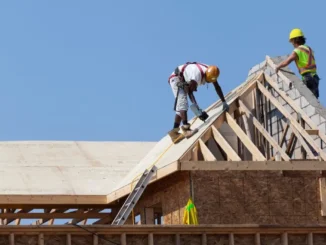
After hours of grueling and sometimes heated negotiations, North Carolina officials are offering edits to their proposal for thicker insulation, more efficient windows, and other improvements in home construction in an effort to win over the state’s developer lobby.
For two years, the Building Code Council had sought to update the state’s 2009-era home energy efficiency code to align it with the latest international guidelines — a step it says would cut consumer energy bills by 19% and unlock millions of dollars in federal grants and incentives.
But the effort hit several roadblocks last month.
Dozens of builders turned out to oppose the update at a public hearing, claiming the costs were three times those estimated by an independent government lab. Allied with the North Carolina Home Builders Association, detractors of the code revamp emerged on the council itself. And a state legislative panel advanced House Bill 488, which would freeze the current code in place until at least 2031.
Even if the proposed new code could clear all these hurdles, it would still likely need ultimate approval from the Republican-controlled General Assembly, which has the power to reject or amend any regulation that draws just 10 individual opponents.
Facing these realities, the ad-hoc committee of code council members, building efficiency experts, architects, and other stakeholders who devised the energy code proposal met early this month with builders and other critics to search for compromise.
Sign up for Energy News Weekly
Get the most important energy news of the week delivered directly to your inbox.
“The state of North Carolina benefits when we work together, and that’s why this conversation was set up,” Bridget Herring, chair of the code council, told those assembled. “If we don’t ever take any incremental steps, this conversation is going to keep getting harder and harder.”
Spread over two days, the talks seemed doomed at first — with opponents of the code overhaul insisting on the status quo and proponents suggesting little in the way of concessions.
And though the Pacific Northwest National Laboratory had affirmed the validity of its latest cost-benefit analysis in an email to Herring on March 31, representatives of the Home Builders Association insisted the research was flawed and would only discuss their own study.
“These are real numbers,” said Gary Embler, a Concord builder and the code council member perhaps most aligned with the Home Builders Association, of the group’s figures.
Several at the meeting doubted that, at least in part. Rob Howard, a general contractor from Granite Falls who has spent most of his construction career with Habitat for Humanity, was especially skeptical of a $1,000 line item attributed to “time to wait on testing, reporting, inspections and approvals due to additional regulations.”
Some of the costs on the association’s spreadsheet, Howard said, “are absolutely correct, and some of them are ridiculously inflated.”
Still, the door to a consensus began to crack open when efficiency proponents took builders at their word and homed on their biggest-ticket items.
One is thicker wall insulation, which can be achieved by framing a house with two-by-six-inch lumber rather than two-by-four. Many builders prefer this method for its stability and efficiency.
“I like to build a quality home,” said Rob Zapple, a member of the code council, Wilmington builder, and advocate for more energy conservation. On the coast, he said, that means making sure homes can withstand powerful winds. “I don’t think I’ve built a two-by-four exterior wall for 15, 18 years.”
But framing a house in this manner tends to be more expensive. “I don’t disagree that there’s a cost to that two-by-six,” Zapple said, “but that cost is absolutely worth it.”
Not for the North Carolina Home Builders Association, which has long fought against thicker wall insulation requirements.
So, though the proposed code already allows compliance with wall insulation rules without switching to two-by-six framing, the energy ad-hoc committee is proposing to add another such option in the mild climate zone that covers most of the state — potentially saving construction costs.
Another big-ticket item: ceiling insulation. As with walls, the thicker the better when it comes to saving energy and preventing heat loss. But this is increasingly less important for most of North Carolina as the climate warms. Thus, the energy ad-hoc committee wants to reduce the ceiling insulation requirement in the climate zone that covers 16 of the state’s 100 counties but beef up the efficacy of windows in that region, along the Tennessee border.
Such concessions, the energy committee hopes, will address builders’ concerns without sacrificing energy efficiency, the opportunity for lower insurance rates, or the chance to apply for federal grants.
As negotiators dove into other parts of the Home Builders Association’s analysis, some of the line-item costs appeared to “melt away,” said Kim Wooten, the head of the energy ad-hoc committee and building code council member.
Some could be addressed with clarifications in the proposed code. Insulation for certain ventilation ducts, for instance, predicted to cost $240, isn’t a requirement. Ditto for $150 lighting controls and a $75 plastic vapor barrier.
And though the Home Builders believed it would cost $3,200 to install high-efficiency HVAC equipment as one means of code compliance, that price tag assumes a gas furnace and an electric air conditioner. Other options to meet the code, such as installing all-electric units, would cost well under $1,000, many at the meeting said.
Still, it isn’t clear whether the developer lobby will agree to these critiques, clarifications and concessions. The next step is for Embler’s own residential ad-hoc committee of current and former code council members and builders to consider them as a package April 27. That group had previously voted to keep the code completely unchanged, with Zapple the lone dissenter.
On and off the council, energy efficiency advocates just want to keep hope alive for some kind of progress.
“So much money is at stake for North Carolina,” Wooten said. “I’m still pushing for compromise instead of sticking with what we have right now.”
Source: Energy News Beat
Sandstone Group



